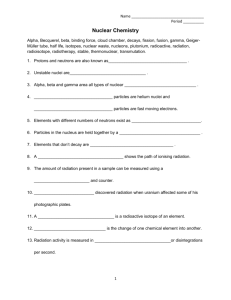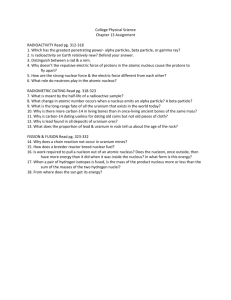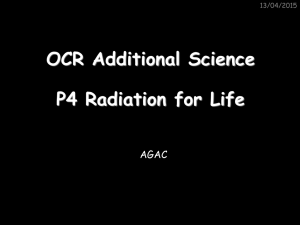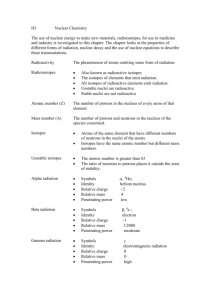OCR Physics P4 - Wey Valley School
advertisement
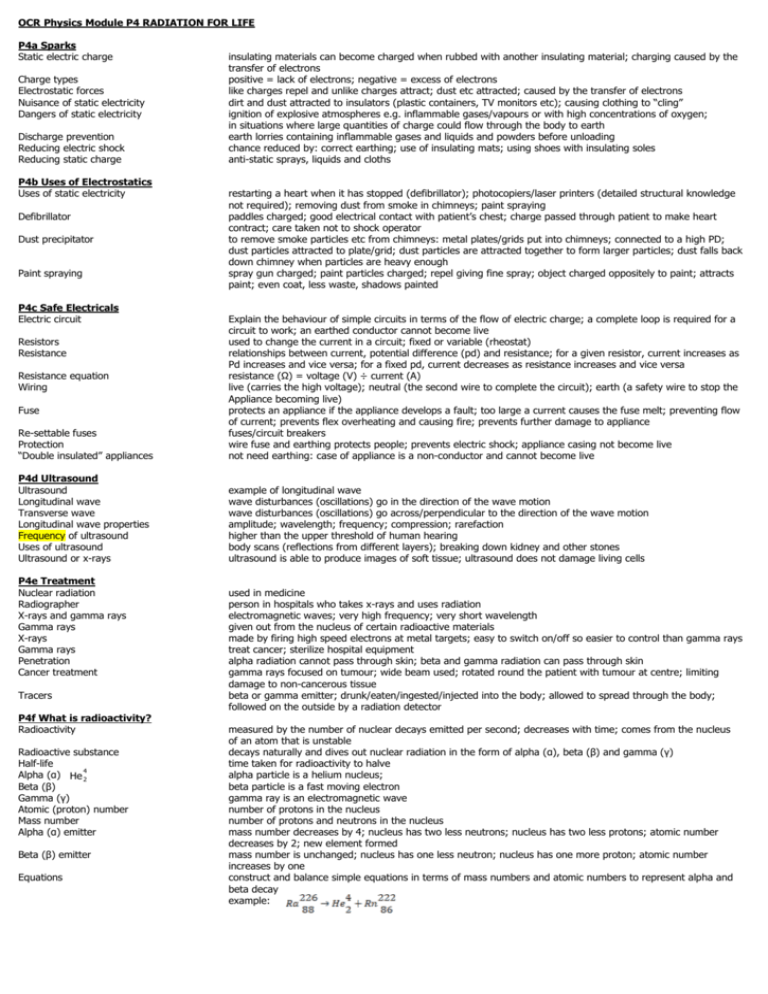
OCR Physics Module P4 RADIATION FOR LIFE P4a Sparks Static electric charge Charge types Electrostatic forces Nuisance of static electricity Dangers of static electricity Discharge prevention Reducing electric shock Reducing static charge P4b Uses of Electrostatics Uses of static electricity Defibrillator Dust precipitator Paint spraying P4c Safe Electricals Electric circuit insulating materials can become charged when rubbed with another insulating material; charging caused by the transfer of electrons positive = lack of electrons; negative = excess of electrons like charges repel and unlike charges attract; dust etc attracted; caused by the transfer of electrons dirt and dust attracted to insulators (plastic containers, TV monitors etc); causing clothing to “cling” ignition of explosive atmospheres e.g. inflammable gases/vapours or with high concentrations of oxygen; in situations where large quantities of charge could flow through the body to earth earth lorries containing inflammable gases and liquids and powders before unloading chance reduced by: correct earthing; use of insulating mats; using shoes with insulating soles anti-static sprays, liquids and cloths restarting a heart when it has stopped (defibrillator); photocopiers/laser printers (detailed structural knowledge not required); removing dust from smoke in chimneys; paint spraying paddles charged; good electrical contact with patient’s chest; charge passed through patient to make heart contract; care taken not to shock operator to remove smoke particles etc from chimneys: metal plates/grids put into chimneys; connected to a high PD; dust particles attracted to plate/grid; dust particles are attracted together to form larger particles; dust falls back down chimney when particles are heavy enough spray gun charged; paint particles charged; repel giving fine spray; object charged oppositely to paint; attracts paint; even coat, less waste, shadows painted Re-settable fuses Protection “Double insulated” appliances Explain the behaviour of simple circuits in terms of the flow of electric charge; a complete loop is required for a circuit to work; an earthed conductor cannot become live used to change the current in a circuit; fixed or variable (rheostat) relationships between current, potential difference (pd) and resistance; for a given resistor, current increases as Pd increases and vice versa; for a fixed pd, current decreases as resistance increases and vice versa resistance (Ω) = voltage (V) ÷ current (A) live (carries the high voltage); neutral (the second wire to complete the circuit); earth (a safety wire to stop the Appliance becoming live) protects an appliance if the appliance develops a fault; too large a current causes the fuse melt; preventing flow of current; prevents flex overheating and causing fire; prevents further damage to appliance fuses/circuit breakers wire fuse and earthing protects people; prevents electric shock; appliance casing not become live not need earthing: case of appliance is a non-conductor and cannot become live P4d Ultrasound Ultrasound Longitudinal wave Transverse wave Longitudinal wave properties Frequency of ultrasound Uses of ultrasound Ultrasound or x-rays example of longitudinal wave wave disturbances (oscillations) go in the direction of the wave motion wave disturbances (oscillations) go across/perpendicular to the direction of the wave motion amplitude; wavelength; frequency; compression; rarefaction higher than the upper threshold of human hearing body scans (reflections from different layers); breaking down kidney and other stones ultrasound is able to produce images of soft tissue; ultrasound does not damage living cells Resistors Resistance Resistance equation Wiring Fuse P4e Treatment Nuclear radiation Radiographer X-rays and gamma rays Gamma rays X-rays Gamma rays Penetration Cancer treatment Tracers P4f What is radioactivity? Radioactivity Radioactive substance Half-life 4 Alpha (α) He 2 Beta (β) Gamma (γ) Atomic (proton) number Mass number Alpha (α) emitter Beta (β) emitter Equations used in medicine person in hospitals who takes x-rays and uses radiation electromagnetic waves; very high frequency; very short wavelength given out from the nucleus of certain radioactive materials made by firing high speed electrons at metal targets; easy to switch on/off so easier to control than gamma rays treat cancer; sterilize hospital equipment alpha radiation cannot pass through skin; beta and gamma radiation can pass through skin gamma rays focused on tumour; wide beam used; rotated round the patient with tumour at centre; limiting damage to non-cancerous tissue beta or gamma emitter; drunk/eaten/ingested/injected into the body; allowed to spread through the body; followed on the outside by a radiation detector measured by the number of nuclear decays emitted per second; decreases with time; comes from the nucleus of an atom that is unstable decays naturally and dives out nuclear radiation in the form of alpha (α), beta (β) and gamma (γ) time taken for radioactivity to halve alpha particle is a helium nucleus; beta particle is a fast moving electron gamma ray is an electromagnetic wave number of protons in the nucleus number of protons and neutrons in the nucleus mass number decreases by 4; nucleus has two less neutrons; nucleus has two less protons; atomic number decreases by 2; new element formed mass number is unchanged; nucleus has one less neutron; nucleus has one more proton; atomic number increases by one construct and balance simple equations in terms of mass numbers and atomic numbers to represent alpha and beta decay example: P4g Use of radioisotopes Background radiation Background radiation – causes Tracers – uses Tracers – how used in industry Smoke detector Dating rocks Carbon-14 dating Carbon-14 dating – measurements P4h Fission Nuclear power stations Electricity production Fission of uranium Chain reaction Chain reaction – of uranium Chain reaction – control Nuclear waste from fission background radiation is in the environment which is always present radioactive substances in rocks and soil; cosmic rays; nuclear testing; waste products – industry; hospitals track dispersal of waste; find leaks/blockages in underground pipes; find the route of underground pipes radioactive material put into pipe; gamma source used so that it can penetrate to the surface; progress tracked with detector above ground; leak/blockage shown by reduction/no radioactivity after this point α particle source; α particles cause ionisation; detected by sensor; smoke particles block α particles; sensor detects lack of ionisation; sets off alarm radioactive dating of rocks depends on the calculation of the uranium/lead ratio measurements from radioactive carbon can be used to find the date of old materials the amount of Carbon 14 in the air has not changed for thousands of years; when an object dies (e.g. wood) gas exchange with the air stops; as the Carbon 14 in the wood decays the activity of the sample decreases; the ratio of current activity from living matter to the activity of the sample leads to a reasonably accurate date use uranium as a fuel nuclear reaction (source of thermal energy); boiler (water to steam); pressure of steam (turns the turbine); production of electricity (turbine turns generator) uranium nucleus hit by neutron; nucleus splits [fission]; matter converted to energy; E=mc2; energy released decay of uranium can be a chain reaction; controlled in nuclear reactor (uranium); uncontrolled in nuclear bomb (uranium/plutonium) when a uranium nucleus splits, more than one neutron is given out; these neutrons can cause further uranium nuclei to split scientists stop nuclear reactions going out of control; rods (carbon/boron) placed in the reactor; absorb some of the neutrons; allow enough neutrons to remain to keep the process operating spent nuclear fuel; materials made radioactive by putting them into a nuclear reactor (absorb extra neutrons)


